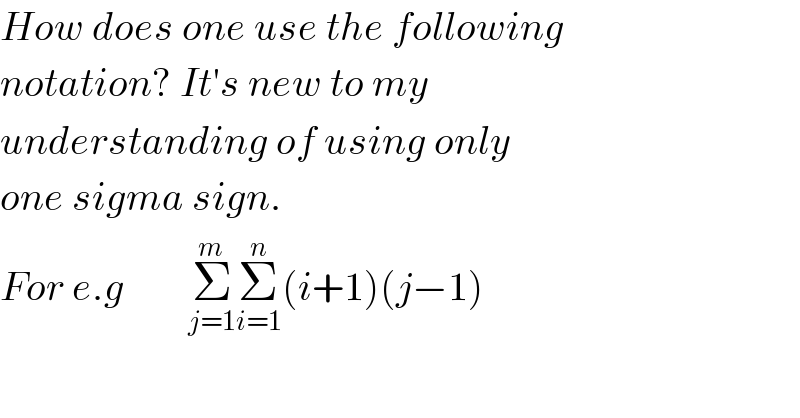
Question Number 1566 by 112358 last updated on 20/Aug/15

$${How}\:{does}\:{one}\:{use}\:{the}\:{following} \\ $$$${notation}?\:{It}'{s}\:{new}\:{to}\:{my}\: \\ $$$${understanding}\:{of}\:{using}\:{only} \\ $$$${one}\:{sigma}\:{sign}. \\ $$$${For}\:{e}.{g}\:\:\:\:\:\:\:\:\underset{{j}=\mathrm{1}} {\overset{{m}} {\sum}}\underset{{i}=\mathrm{1}} {\overset{{n}} {\sum}}\left({i}+\mathrm{1}\right)\left({j}−\mathrm{1}\right) \\ $$
Commented by Rasheed Soomro last updated on 20/Aug/15

$${Consider}\:{it}\:{as} \\ $$$$\:\:\:\:\:\underset{{j}=\mathrm{1}} {\overset{{m}} {\sum}}\left(\underset{{i}=\mathrm{1}} {\overset{{n}} {\sum}}\left({i}+\mathrm{1}\right)\left({j}−\mathrm{1}\right)\right) \\ $$
Commented by 112358 last updated on 20/Aug/15
![So for e.g Σ_(j=1) ^3 (Σ_(i=1) ^4 (i+1)(j−1))=Σ_(j=1) ^3 {(j−1)[2+3+4+5]} =Σ_(j=1) ^3 {14(j−1)} =14×0+14×1+14×2 =42 ?](Q1569.png)
$${So}\:{for}\:{e}.{g} \\ $$$$\underset{{j}=\mathrm{1}} {\overset{\mathrm{3}} {\sum}}\left(\underset{{i}=\mathrm{1}} {\overset{\mathrm{4}} {\sum}}\left({i}+\mathrm{1}\right)\left({j}−\mathrm{1}\right)\right)=\underset{{j}=\mathrm{1}} {\overset{\mathrm{3}} {\sum}}\left\{\left({j}−\mathrm{1}\right)\left[\mathrm{2}+\mathrm{3}+\mathrm{4}+\mathrm{5}\right]\right\} \\ $$$$=\underset{{j}=\mathrm{1}} {\overset{\mathrm{3}} {\sum}}\left\{\mathrm{14}\left({j}−\mathrm{1}\right)\right\} \\ $$$$=\mathrm{14}×\mathrm{0}+\mathrm{14}×\mathrm{1}+\mathrm{14}×\mathrm{2} \\ $$$$=\mathrm{42}\:\:? \\ $$$$ \\ $$
Commented by Rasheed Soomro last updated on 20/Aug/15
![I think so. Alternate way(for testing your answer) i=1,2,3,4 ; for each i, j=1,2,3 Let A_i ={1,2,3,4} and A_j ={1,2,3} Evaluate the expression [ (i+1)(j−1)]for every pair (i,j) of A_i ×A_j and then add.](Q1570.png)
$${I}\:{think}\:{so}. \\ $$$${Alternate}\:{way}\left({for}\:{testing}\:{your}\:{answer}\right) \\ $$$${i}=\mathrm{1},\mathrm{2},\mathrm{3},\mathrm{4}\:;\:{for}\:{each}\:{i},\:{j}=\mathrm{1},\mathrm{2},\mathrm{3} \\ $$$${Let}\:{A}_{{i}} =\left\{\mathrm{1},\mathrm{2},\mathrm{3},\mathrm{4}\right\}\:\:{and}\:\:{A}_{{j}} =\left\{\mathrm{1},\mathrm{2},\mathrm{3}\right\} \\ $$$$\:\:\:\:\:\:\:{Evaluate}\:{the}\:{expression}\:\left[\:\left({i}+\mathrm{1}\right)\left({j}−\mathrm{1}\right)\right]{for}\:{every}\:{pair}\:\left({i},{j}\right)\:\:{of}\:{A}_{{i}} ×{A}_{{j}} \\ $$$${and}\:{then}\:{add}. \\ $$
